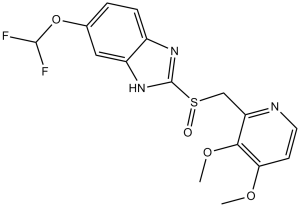This product is for research use only, not for human use. We do not sell to patients.

| Size | Price | Stock |
|---|---|---|
| 2g | $400 | Check With Us |
| 5g | $700 | Check With Us |
| 10g | $1050 | Check With Us |
Cat #: V1637 CAS #: 102625-70-7 Purity ≥ 98%
Description: Pantoprazole (BY1023; SKF96022; BY-1023; SKF-96022; Protonix), an approved anti-ulcer drug, is a proton pump inhibitor (PPI) used for short-term treatment of erosion and ulceration of the esophagus caused by GERD (gastroesophageal reflux disease).
Publications Citing InvivoChem Products
Product Promise

- Physicochemical and Storage Information
- Protocol
- Related Biological Data
- Stock Solution Preparation
- Quality Control Documentation
| Molecular Weight (MW) | 383.37 |
|---|---|
| Molecular Formula | C16H15F2N3O4S |
| CAS No. | 102625-70-7 |
| Storage | -20℃ for 3 years in powder formr |
| -80℃ for 2 years in solvent | |
| Solubility In Vitro | DMSO: 76 mg/mL (198.2 mM)r |
| Water:<1 mg/mLr | |
| Ethanol: 76 mg/mL (198.2 mM) | |
| Synonyms | BY1023; SKF96022; Protonix; BY 1023; SKF 96022; BY-1023; SKF-96022 |
| Protocol | In Vitro | Pantoprazole (BY1023; 1-10000 μM) leads to concentration-dependent increases in endosomal pH in EMT-6 and MCF7 cells |
|---|---|---|
| In Vivo | Pantoprazole (BY1023; 200 mg/kg; IP; once a week for 3 weeks) significantly increases tumor growth delay of MCF-7 xenografts combined with Doxorubicin. | |
| Animal model | Mice bearing MCF-7 or A431 xenografts | |
| Dosages | 200 mg/kg | |
| Administration | IP; once a week for 3 weeks; alone or 2 hours before Doxorubicin (6 mg/kg i.v.) |
| Solvent volume to be added | Mass (the weight of a compound) | |||
|---|---|---|---|---|
| Mother liquor concentration | 1mg | 5mg | 10mg | 20mg |
| 1mM | 2.6084 mL | 13.0422 mL | 26.0845 mL | 52.1689 mL |
| 5mM | 0.5217 mL | 2.6084 mL | 5.2169 mL | 10.4338 mL |
| 10mM | 0.2608 mL | 1.3042 mL | 2.6084 mL | 5.2169 mL |
| 20mM | 0.1304 mL | 0.6521 mL | 1.3042 mL | 2.6084 mL |
This equation is commonly abbreviated as: C1 V1 = C2 V2
- (1) Please be sure that the solution is clear before the addition of next solvent. Dissolution methods like vortex, ultrasound or warming and heat may be used to aid dissolving.
- (2) Be sure to add the solvent(s) in order.




































